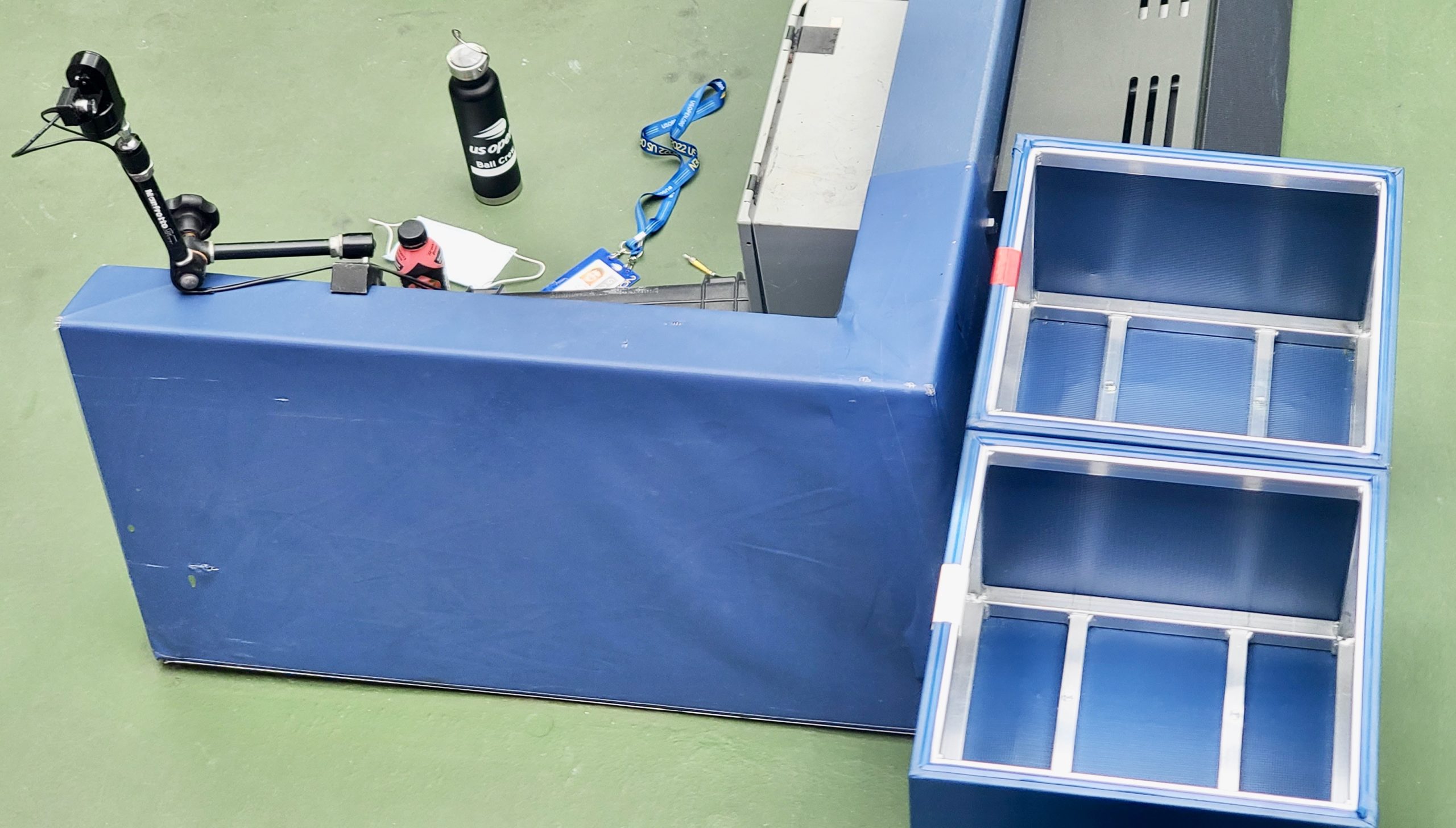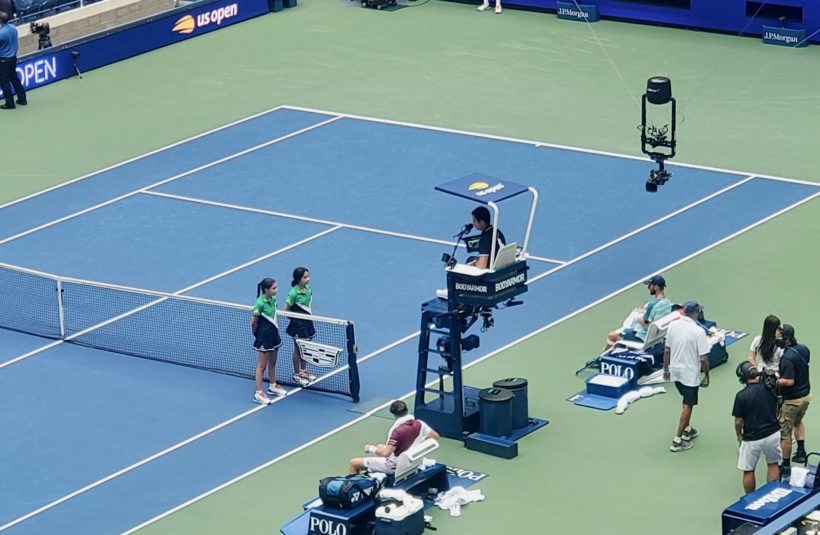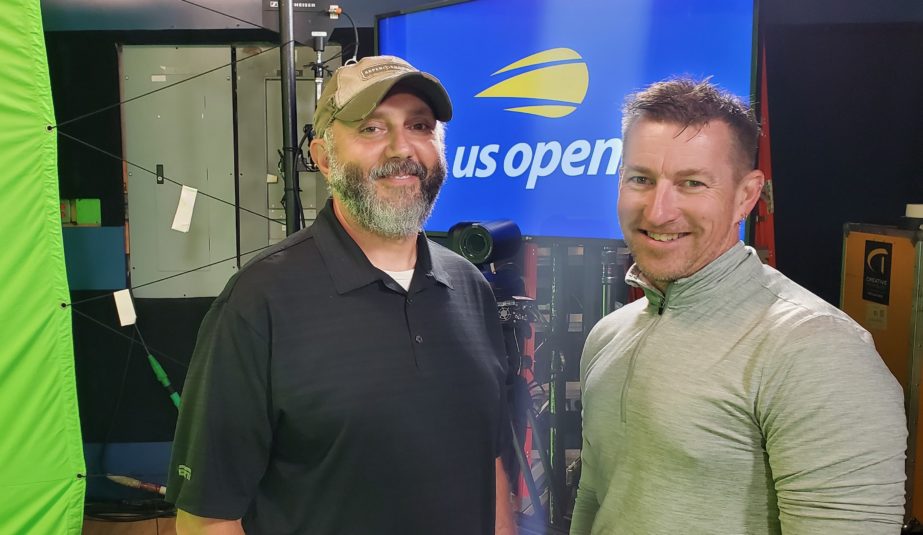Live From US Open 2022: Rightsholders’ Needs, Team of Partners Drive USTA’s Innovations
New tech includes UHD on Arthur Ashe, 1080p on other show courts
Story Highlights
The 2022 US Open Tennis Championships at the USTA Billie Jean King National Tennis Center in Queens, New York, have taken things to a new level. Record crowds are matched by record viewing audiences on ESPN, and the USTA is working to deliver in new ways for rightsholders and tennis fans around the globe. Over the past two years, the US Open production effort was reshaped by the pandemic, but this year’s operation, masks aside, feels pretty much back to normal, and the team was able to embrace new technologies, including UHD on Arthur Ashe Stadium and 1080p on the remaining show courts.
USTA Managing Director, Broadcast Patti Fallick (and the USTA production team) have spent a large portion of their waking days in the USTA Broadcast Building, located across the road behind Arthur Ashe Stadium. And after two years of smaller representation by rightsholders due to COVID, both old and new rightsholders are onsite in force.
“It has been great to have the broadcast building fully utilized with all of our broadcast partners onsite,” she says. “We also have a lot of new broadcast partners this year, like Nine in Australia, ECLAT/Spo-TV in Southeast Asia, Spark in New Zealand, and Sony in India. And everybody has sent crews, no matter where they are from in the world. Everybody was just happy to be back onsite, even before we knew about Serena Williams.”
The big news this year is the leap to UHD and 1080p, both important moves to keep rightsholders around the world happy, especially because UHD deployment has become a reality in Europe, Japan, India, and China.
“We were planning for 1080p and also for UHD for a while because, in a lot of instances, it’s a contractual obligation with rightsholders,” Fallick explains. “COVID derailed those plans for a while, but we’re happy to be able to offer 1080p to rightsholders. I think the improved quality of the feed is noticeable.”
Use of native UHD for matches in Arthur Ashe Stadium puts the USTA at the technology forefront. True native-UHD production is the exception in the U.S., even for content ultimately delivered to viewers in UHD.
“We were considering UHD for Arthur Ashe and worked closely with our partners at ESPN, in their role as host for the US Open, to move in that direction,” says Fallick. “It was a challenge to figure out the workflow and kudos to the engineering team led by ESPN Senior Remote Operations Specialist Sam Olson and Senior Technical Specialist Steve Raymond, NEP Senior Project Manager Nick Romano, and Gravity Media Director, Special Projects, Hamish Harris and his team. Everybody worked together to figure out how we can do 1080p and native UHD.
“Our goal,” she continues, “was to make sure that every entity that receives a video signal — whether that be SMT, Hawkeye, our in-house IPTV system, broadcasters, TOC, or other touchpoints — could get the signals in 1080p and would be able to receive it into their individual infrastructures. It took some doing to pull it off, and, candidly, I held my breath until we made the final switchover. But it worked out really well, thanks to the hard work and efforts by the ESPN host technical teams and all the communication and collaboration by the different vendors.”
The move to UHD had a ripple effect on the USTA’s world-feed graphics package as well as archiving and file distribution.
“We hadn’t updated our graphics package in a long time,” notes Fallick. “SMT designed a really modern look for our new UHD graphic package for the world feed. It’s clean, bright, and modern and puts us one step ahead on that front, as we move towards more UHD coverage.”
With respect to file distribution and archiving, she says the teams at Veritone and Thumbwar stepped up to the challenge in a big way: “When we first started talking about UHD, our partners from Veritone, who handle that content, looked at me and said, ‘That’s going to be a lot of content.’ But it turned out to be fortuitous because we now have Serena’s last US Open run in UHD, including iso cams, and that is a win all around. But, yes, it is a lot more content for them to move into the cloud and archive.”

A new addition to US Open coverage is the “towel cam,” a miniature camera mounted a few feet behind each towel bin at Arthur Ashe Stadium.
The USTA also pushed ESPN to create a new look with the addition of cameras behind the towel bins and the return of the Spidercam cabled aerial camera system to Louis Armstrong Stadium, the court located next to Arthur Ashe that hosts the second-most-important matches.
“It elevates the look and feel of coverage, and, at home, it feels bigger,” says Fallick. “Kudos to Jamie and the team.”
Williams’s announcement that the US Open would be her final event set off a chain reaction of not only ticket requests but also how to honor one of the greatest tennis players of all time.
“The fact that Serena announced that she wanted to do it here was special,” says Fallick. “We wanted to find a unique, special way to honor her and do a special tribute. Our Managing Director, Marketing, Nicole Kankam; Director, Marketing, Nicole Munroe; and Executive Producer, US Open Productions, Michael Fiur; and ESPN, VP, Production, Jamie Reynolds spent a lot of time brainstorming, along with our Tournament Director Stacey Allaster. How can we do this and find the right tone? What’s the right video, and what’s the right presentation?
“It was special and electric,” Fallick continues, “especially seeing Serena’s reaction to the video and the card stunt of ‘We Heart Serena’ in the stands. She loved the opening-night presentation. And then she kept on winning, so we were thinking ‘what do we do next?’ I couldn’t be prouder of how the USTA came together with our partners to figure out how to capture the moment, capture the magic, and make her feel appreciated as the special GOAT that she is.”
A Workaround That Stuck Around
One of the pandemic innovations that remains in place is an interview studio featuring nothing but a chair, a large green screen (floor and three walls), a large monitor, and robotic cameras. Robotic cameras coupled with an Unreal Engine allow players to be placed within a virtual interview room that makes them appear to be in US Open-branded space and a compelling virtual environment.
“That started in 2020,” says Fallick. “We wanted the players to be able to be interviewed by broadcast partners from around the world who weren’t onsite due to the pandemic. We went to NEP for some help, and their Creative Technologies team came up with a great solution with robotic cameras. We didn’t have to worry about COVID as players would walk in by themselves, put the mic on by themselves, sit down in a chair, and nobody else is in the room with them: they just do their interview [with the interviewer on a monitor in front of them].”
According to Creative Technologies Account Manager Jeff Chenery, the move to 1080p has improved things because the studio has always operated in 1080p and now the content can be delivered to the Veritone server without conversion. The green screen was also lowered so that the system could better process green-screen captures where the athletes may be shiny due to sweat or have a reflective trophy or even an outfit with some green.
“The players love it,” he says, “and we’ve helped rightsholders get additional access to players for their home-country studios, in addition to their onsite US Open presence.”
Adds Fallick, “It has worked well, and the players and our broadcasting partners around the world appreciate it because they get unique access to the players. We will probably do around 200-plus interviews from the virtual studio. It gives the broadcasters a chance to feel bigger to their audience in their coverage of the US Open.”
NEP Project Manager Nick Romano oversees NEP Group’s efforts: Creative Technologies and the interview studio and LED screens at Arthur Ashe; Supershooter 9, on hand for DirecTV’s ITV coverage; Chromium and Nickel, handling the world feed; Fletcher, handling the ACES camera systems; and Bexel.
“It’s a nice showing what we can do as a company to support the USTA,” he says. “Now, with Supershooter 9 in the IP realm, we can basically extend the router away from the truck, and, with our TFC broadcast control, IP becomes extremely easy to deploy between two trucks or a Bexel or Creative Technologies kit.”
Beyond Broadcast
The USTA is also involved with a number of documentary and long-form projects, in addition to all the broadcast work.
“We’re also involved with a Netflix project with Box to Box productions that needs behind-the-scenes access,” says Fallick. “There is also a Serena–Amazon documentary crew that has been here for the last three years. We have crews shooting for those entities uploading more 4K content, and, thanks to the Veritone and Thumbwar team, that has gone well because they understand how important the content is and how to archive it. Greg Loose and Garron Bateman of Veritone worked closely with Brian Carr and the team at Thumbwar to come up with solutions that worked. No matter what challenge I threw at them, they came up with solutions, and that’s why the partnership works.”
Ever since F1 and Netflix found a hit with Drive To Survive, major sports leagues and federations have been looking for similar success. Both the U.S. Open golf championship and The Open Championship in Scotland this year featured additional camera crews running around capturing behind-the-scenes content and interviews. It brings a new energy to the compound and event but also more entities to manage.
For example, adds Fallick, Boardwalk Productions’ Frank Baglino and Rob Newman have five ENG crews at the US Open looking for unique shots that might not appear in the broadcast coverage.
“They’re shooting 4K, they’re shooting with specialty lenses, and they’re capturing the feeling of being on the grounds of the US Open,” she says. “We provide that footage to our international rightsholders in what we call our daily Flavor Reel because some of them are either not onsite or have limited resources to capture the additional flavor of the event. That content goes up on the Digital Media Hub that Veritone manages for us, and we give rightsholders access to it from across the world. It’s enabling our global broadcasters around the world to cover the US Open at the highest level possible and give viewers the feeling they are right here.”
Long-Term Partners
Key to all the efforts are long-term partnerships with companies like NEP, Gravity Media, and ESPN. Fallick likens the Billie Jean King Tennis Center to Switzerland, where disparate (and sometimes competitive) production-service providers work together for the common good.
“There’s the saying it takes a village, and it’s true,” she says. “We also have our crew that comes back every year for the world-feed production, even with all the other work that they could be getting in the New York area. So we’re really, truly fortunate that they’re invested in the product and love working with us, as it’s about taking care of people, at the end of the day. It’s about relationships, it’s about working together, and it’s gotta be a win-win for everybody. That has always been my number-one priority in my career: to develop those long-term relationships and trust and understanding that it has to work for everybody.”
For all the technology, Fallick says, the most important thing are the people powering the production efforts.
“[USTA] Senior Manager, Broadcast Operations, Dayna Navatta is nothing short of a rock star,” says Fallick. “She had a baby just six months ago and hasn’t lost a beat. I don’t know how she’s doing it. She is truly amazing: handling the partners coming in and asking questions all day/night, working closely with tournament operations, and working closely with the operational facility to support the broadcast operation.”
All the efforts — digital, broadcast, even in-venue — point to the classic mantra that content is king. But, she adds, live sports content is always going to drive the boat, no matter what format it is delivered in.
“It has to be live, and it has to be in the moment,” she explains. “There are more and more ways to deliver content than ever before. But you can’t sit by and not get involved in new technologies, especially as we want to be known as the innovative Slam. When I was hired, now-USTA CEO Lew Sherr told me it would take about five years for me to get the venue, the facility, staff, and the world-feed production up to a higher level.
“Now I think we’re starting the next five-year plan,” Fallick continues, “so we can make sure that we continue to deliver the US Open at the highest level possible to our global audience. But that’s why I love my job: the challenges are constantly changing. How can we keep on pushing the envelope to deliver the US Open at the highest level possible? I am extremely lucky that our CEO and senior leadership team support our efforts and understand the value of what we do for the coverage of the US Open.”


